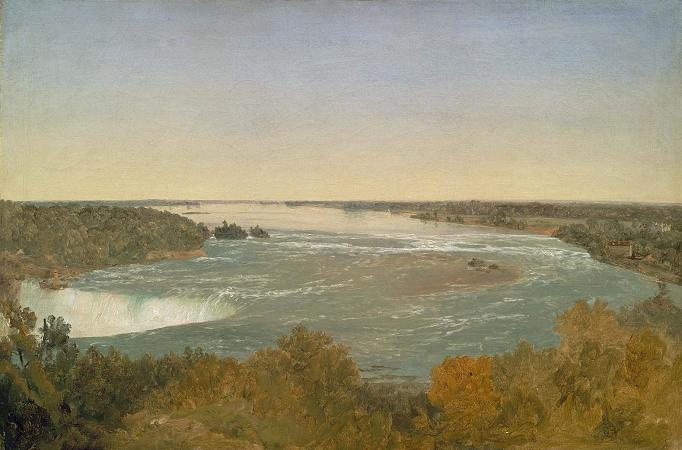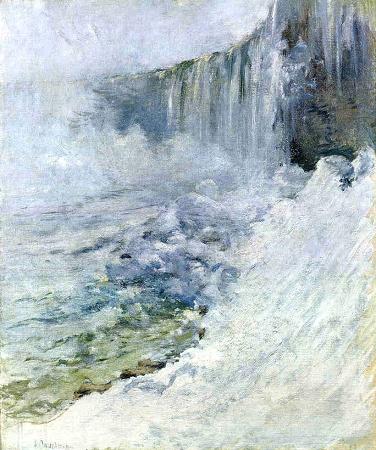Niagara Falls. Niagara Falls is a group of three waterfalls at the southern end of Niagara Gorge, between the Canadian province of Ontario and the US state of New York. The largest is Horseshoe Falls, also known as Canadian Falls, which straddles the international border between Canada and the United States. The smaller American Falls and Bridal Veil Falls lie entirely within the United States. Bridal Veil Falls are separated from Horseshoe Falls by Goat Island and from American Falls by Luna Island. Located on the Niagara River, which drains Lake Erie into Lake Ontario, the combined falls have the highest flow rate of any waterfall in North America that has a vertical drop of more than 50 metres. During peak daytime tourist hours, more than 168,000 m 3 of water goes over the crest of the falls every minute. Horseshoe Falls is the most powerful waterfall in North America, as measured by flow rate. The falls are 27 kilometres north-northwest of Buffalo, New York, and 121 kilometres south-southeast of Toronto, between the twin cities of Niagara Falls, Ontario, and Niagara Falls, New York. Niagara Falls was formed when glaciers receded at the end of the Wisconsin glaciation, and water from the newly formed Great Lakes carved a path through the Niagara Escarpment en route to the Atlantic Ocean. Niagara Falls is famed both for its beauty and as a valuable source of hydroelectric power. Balancing recreational, commercial, and industrial uses has been a challenge for the stewards of the falls since the 19th century. The Horseshoe Falls drop about 57 metres, while the height of the American Falls varies between 21 and 30 metres because of the presence of giant boulders at its base. The larger Horseshoe Falls are about 790 metres wide, while the American Falls are 320 metres wide. The distance between the American extremity of the Niagara Falls and the Canadian extremity is 3,409 feet. The peak flow over Horseshoe Falls was recorded at 6,400 cubic metres per second. The average annual flow rate is 2,400 cubic metres per second. Since the flow is a direct function of the Lake Erie water elevation, it typically peaks in late spring or early summer. During the summer months, at least 2,800 cubic metres per second of water traverses the falls, some 90% of which goes over the Horseshoe Falls, while the balance is diverted to hydroelectric facilities. This is accomplished by employing a weir-the International Control Dam-with movable gates upstream from the Horseshoe Falls. The falls' flow is further halved at night, and, during the low tourist season in the winter, remains a minimum of 1,400 cubic metres per second. Water diversion is regulated by the 1950 Niagara Treaty and is administered by the International Niagara Board of Control. The verdant green colour of the water flowing over the Niagara Falls is a byproduct of the estimated 60 tonnes/minute of dissolved salts and rock flour generated by the erosive force of the Niagara River itself. The features that became Niagara Falls were created by the Wisconsin glaciation about 10,000 years ago. The same forces also created the North American Great Lakes and the Niagara River. All were dug by a continental ice sheet that drove through the area, deepening some river channels to form lakes, and damming others with debris. Scientists argue there is an old valley, St David's Buried Gorge, buried by glacial drift, at the approximate location of the present Welland Canal. When the ice melted, the upper Great Lakes emptied into the Niagara River, which followed the rearranged topography across the Niagara Escarpment. In time, the river cut a gorge through the north-facing cliff, or cuesta. Because of the interactions of three major rock formations, the rocky bed did not erode evenly. The top rock formation was composed of erosion-resistant limestone and dolomite of the Lockport Formation. That hard layer of stone eroded more slowly than the underlying materials. The aerial photo on the right clearly shows the hard caprock, the Lockport Formation, which underlies the rapids above the falls, and approximately the upper third of the high gorge wall. Immediately below the hard-rock formation, comprising about two-thirds of the cliff, lay the weaker, softer, sloping Rochester Formation. This formation was composed mainly of shale, though it has some thin limestone layers. It also contains ancient fossils. In time, the river eroded the soft layer that supported the hard layers, undercutting the hard caprock, which gave way in great chunks. This process repeated countless times, eventually carving out the falls.
more...













